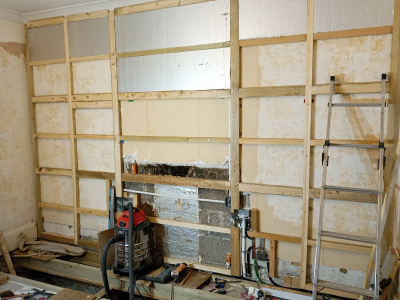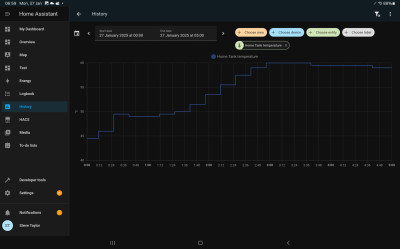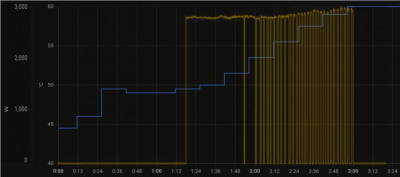Posted by: @clockworksIt might be a good idea if some "randomisation" of schedules and timers was standard on electric heating systems though
There are randomised delays available... but they're not properly implemented,
and sometimes not at all.
All Smart Meters have a randomised offset to the Tariff table which the specification sets at 1-1799 seconds.
But Energy Suppliers are migrating away from it because their billing software couldn't 'understand' how to handle it.
That's a lazy option, and detrimental to the grid.
The correct approach is to get the billing software right!
All Smart EV-chargers also incorporate a randomised offset, up to 10-mins.
That's stipulated by the Electric Vehicles Smart Charging regulations (2021), Section-11.
However, that interacts with the randomised delay in the Smart Meters, meaning that consumers are being incorrectly billed, but can't work out how.
As for your own EV charger:
Posted by: @clockworksthe charger is controlled by the energy supplier (Octopus). They tell the charger when to run, and can also knock the max current back if needed.
I'd quibble with that.
Octopus' tariffs are based on national supply & demand data.
It's a strategy based on price in pounds sterling.
Electricity operates in kW, not pounds.
The 'pinch-points' of the electricity grid are mainly in the regional distribution network.
And the level of greatest concern is the massive 11kV infrastructure.
Octopus can't 'see' that.
They have no idea when the 11kV supply to your local substation is operating at or above capacity.
To reach Net Zero we have to 'flatten the peaks' rather than simply keep adding more generation/storage to the grid.
Save energy... recycle electrons!
@clockworks Regarding the Cosy tariff and heat pumps, here are a couple of extracts from recent communications I have had from O.E.
“Thank you for reaching out! I'm glad to hear you're interested in integrating your Daikin Heat Pump with our Cosy Intelligent system.
Cosy Intelligent is designed to optimise your heating and energy usage by seamlessly connecting your heat pump, solar panels, and battery storage. By granting access, we can help manage your energy consumption more efficiently, ensuring you benefit from lower costs and a greener energy profile.
Here’s how it works:
- Optimisation: Cosy Intelligent will adjust your heat pump's operation based on energy prices and your usage patterns, helping you save money.
- Integration: It allows for better coordination between your heat pump, solar PV, and Tesla Powerwall, maximising the use of renewable energy.
- Data Insights: You’ll receive insights into your energy usage, helping you make informed decisions about your heating and energy consumption.
By joining Cosy Intelligent, you, Octopus Energy, and Energy UK can work together towards a more sustainable energy future, reducing carbon emissions and promoting the use of renewable energy sources.”
I replied that as such, I was already making the most of the Cosy tariff as I am charging my battery during those 8 cheapest hours and not using any grid power at other times. In a reply to this, the lady wrote:
”Thank you for your reply and for sharing the details of your setup—it’s great to see how efficiently you’re managing your energy system! I’d like to clarify that my earlier response referred to the Cosy Tariff you’re already on, not a new Intelligent Cosy feature (apologies for any confusion caused).
The Cosy Tariff is designed to offer lower rates during off-peak hours, helping you optimise energy usage for systems like your Tesla Powerwall, MyEnergi Eddi, and Sunamp Thermino. With your current setup, you’re already taking full advantage of the tariff’s structure by aligning your Powerwall and heat pump usage with the low-rate period.
While the Cosy Tariff itself doesn’t add new features beyond the pricing benefits, it’s fantastic to hear how you’re already integrating various smart technologies to make the most of it. If any additional tools or features become available that could enhance your system’s efficiency, I’ll ensure you’re informed.
Let me know if you have any other questions, or if there’s anything specific you’d like support with.”
When I had looked at the OE site, Constantine was giving me that ‘Come on, you know you want to integrate your heatpump’ look so I followed the link, not so much an explanation, more a very swift means to join the scheme! I had to enter model of heat pump and then click the button… I was as good as signed up but, I think as Homely already have control of the system, the attempt to take control failed. Just as well as I was only collecting information about possibilities then. (I like to keep up with these things y’know!) Regards, Toodles.
Toodles, heats his home with cold draughts and cooks food with magnets.
Can't the suppliers, or at least the smart meter network people, tell when local demand is straining the grid by just looking at the supply voltage at each meter?
That would seem to be a relatively easy way of getting the required data, assuming that the voltage drops as demand increases?
I was meaning the Cosy range of heat pumps that Octopus are pushing, not the confusingly-named Cosy tariff. I think Octopus get live data from these heatpumps, or, at least they can communicate with them to set them up, etc.
Perhaps for clarity, I should mention that I used the term ‘Energy UK’ in my email to OE; I used it as a generic term for the generation and distribution organisations involved who are providing the energy we use.
‘Cosy Intelligent’ is a term that O.E. are using on their website and I wanted clarification about it. Regards, Toodles.
Toodles, heats his home with cold draughts and cooks food with magnets.
@clockworks And it would appear that they can control some other (non-Cosy) heat pumps too. They appear to be able to work with Daikin; this may be because they have been supplying Daikin pumps themselves for several years. Regards, Toodles.
Toodles, heats his home with cold draughts and cooks food with magnets.
Posted by: @clockworksCan't the suppliers, or at least the smart meter network people, tell when local demand is straining the grid by just looking at the supply voltage at each meter?
That would seem to be a relatively easy way of getting the required data, assuming that the voltage drops as demand increases?
You are making all the 'right' points @clockworks
... which gives me a dilemma because I'm meant to be installing an internal-insulation wall this afternoon.
... and I'd much rather be discussing this with you. 🙂
Electricity Suppliers aren't interested in collecting data from Smart Meters unless
- the regulator (Ofgem) requires them to
- there's a way of making a profit
Distribution Network Operators (DNOs) can obtain an anonymised set of data for each of the 230,000 ground-mounted sub-stations.
They're unlikely to be interested in voltage swings unless there's a risk of them falling outside of limits imposed by The Electricity Safety, Quality and Continuity Regulations (2002), Section-27. That defines the single-phase supply as 230v minus 6% to plus 10%, which equates to 216.2v - 253v
Voltage and current are not fixed parameters on the grid.
The only static requirement is that it must operate at 50Hz.
If excess demand causes the frequency to drop too low, then it becomes impossible to 'join' additional generation onto the grid.
DNOs tend to concentrate on
- safety
- security
- the targets set in their RIIO-ED2 agreement with Ofgem
The latter is the rule-set which means their shareholders could lose dividend payments.
One of those targets is losses due to phase imbalance at the substation.
So that's worthwhile putting a bit of effort into.
The present approach to constraints imposed by the grid is for DNOs to ask Ofgem to allow them to build more infrastructure.
That's easy to achieve because:
- infrastructure upgrades are mainly funded by consumers paying more for their electricity
- Ofgem doesn't hear alternative viewpoints from consumers because they're the industry regulator
I'm 'working' on two projects which do rely on feedback from the status of the local grid.
But it's privately-funded so Ofgem and the Government are unaware.
Even when we succeed in finding a solution, it can't be turned into a 'product' because there's no requirement for Suppliers to offer a Nodal Tariff.
That's a tariff price structure based on sub-national parameters.
These are all issues which can readily be resolved over a couple of pints in a West Country pub,
but defy the combined efforts of Government and the commercial energy sector.
Save energy... recycle electrons!
I've just superimposed those and adjusted the x-axis to make the time-frames coincide...
I think Mitsubishi need to justify the need to send the immersion-heater into a pulse-width modulation mode.
I could understand it if the set-temperature of 60°C was being maintained, but that's clearly not the case.
The first 'switch off/on' is occurring with the temperature sensor recording 52°C.
Save energy... recycle electrons!
I think the switching is because the thermostat in the immersion heater element is switching on and off because the water close to the element is reaching 60 degrees. The hot water then dissipates, rising to the top of the tank. Cooler water reaches the immersion thermostat sensor, so it switches on again.
Remember, the max setting of the immersion thermostat is only 60 degrees, and the immersion element is near the bottom of the tank.
Meanwhile, the Mitsubishi is monitoring the temperature of the water about halfway up the tank. The water here is cooler than the water right by the element. It sees the temperature rising slowly, but barely reaching 60 degrees at the end of the 2 hour cycle. It's not getting any feedback from the actual immersion heater, just from the tank sensor halfway up.
From what I can see, the immersion supply from the consumer unit (which is what I'm measuring) just goes through a simple relay in the Mitsubishi controller. The controller just closes the relay when it realises that it can't get up to temperature on its own, and it needs assistance from the immersion heater.
It keeps the relay closed until the tank sensor gets to 60 degrees, or until the 2 hour cycle times out.
I think I just need an immersion element thermostat that switches at a higher temperature. They make one with a 63 to 71 degree adjustment range. The one fitted currently has a range of 52 to 60 degrees.
With the higher rated thermostat, the immersion would just run constantly. The water would be circulating as the hot water rose, never actually reaching the 70 degree cutout point. The water would warm up a lot faster, and the Mitsubishi sensor would end the cycle when it read 60 degrees. That should take about an hour I think.
OK @clockworks - I agree with your analysis.
So what you're seeing here is due to the relatively slow rate at which heat is rising in the tank.
Posted by: @clockworksThe controller just closes the relay when it realises that it can't get up to temperature on its own, and it needs assistance from the immersion heater.
I think the Ecodan algorithm should be sensing when the DHW temperature reaches 50°C,
at which point it's more efficient to run the immersion heater for the final 10°C rise.
Save energy... recycle electrons!
Looking at the ASP flow temp, it does indeed switch over to the immersion at 50 degrees.
I've spoken to the installer, and they will replace the thermostat. Took a while to get him to understand what was going on.
Thinking back to when it was being installed, I remember the plumber saying "I've had to rob the immersion heater from your order to use it on another job. I'll pick another one up for tomorrow".
Maybe the correct thermostat was specced and ordered, and he just picked up an incorrect replacement?
- 26 Forums
- 2,364 Topics
- 53.6 K Posts
- 72 Online
- 6,029 Members
Join Us!
Worth Watching
Latest Posts
-
-
RE: Octopus Cosy Heat Pump Owners & Discussion Thread
@kevh it's worth remembering that many lsvs only actual...
By JamesPa , 13 hours ago
-

@majordennisbloodnok Education, Education, Education…
By Toodles , 16 hours ago
-

RE: Setback savings - fact or fiction?
Exactly. We only need to compare conditions, to decide ...
By cathodeRay , 20 hours ago
-
RE: Balancing financial efficiency and comfort using the Octopus Cosy tariff
I found because I have very low heat loss I can set bac...
By RadWhisperer , 23 hours ago
-
RE: Need Help Optimising My Rushed ECO4 Install: 12kW Bosch Heat Pump
Welcome @mickamills We too have an oversized 12kW Sa...
By Old_Scientist , 1 day ago
-
RE: My Powerwall 3 Consumes 3-4 kWh/Day in Self-Consumption: Is This Normal?
@caron I can confirm that the power usage of the PW3 is...
By Old_Scientist , 1 day ago
-
RE: Speedcomfort radiator fans
Thats true, but having tried (and succeeded) in constru...
By JamesPa , 1 day ago
-
RE: Solis S6-EH1P8K-L-PLUS – Why I Chose It and What I’ve Learned So Far
@bash brilliant, thanks for the feedback
By energy9165 , 1 day ago
-

RE: Heat Pump Heats the House… But It’s Not Cosy. Emitter Changes or System Tweak?
@alastair There I was, feeling grumpy, he said “Cheer u...
By Toodles , 2 days ago
-
RE: Grant Aerona: Is there a setting to keep the 2-port valve open during pump blockade
Depends on OAT. Mine cycles at OAT>10 and of course...
By JamesPa , 2 days ago
-
RE: New Fogstar 15.5kWh upright solution
@transparent My conclusion is as you have noted, tha...
By Bash , 2 days ago
-
RE: Mitsubishi Ecodan R290 10kW performance
And to you too. Wishing you a very enjoyable festive s...
By Sheriff Fatman , 2 days ago
-

RE: External pipework insulation
They do? But that isn't apparent from the photos we'r...
By Transparent , 2 days ago
-

RE: Say hello and introduce yourself
@velcro welcome to the forums. Please feel free start a...
By Mars , 2 days ago
-
Daikin EDLA11D3V3 DHW Settings
I have a newly installed EDLA11D3V3 which I'm still get...
By Velcro , 2 days ago
-
RE: Midea ASHP – how to set weather compensation
@curlykatie did you get sorted with this?
By MickaMills , 3 days ago
-
RE: MyVaillant Connect Regular Disconnect
Thanks. Yes, if the time is consistently 11pm every nig...
By buckwem , 3 days ago








